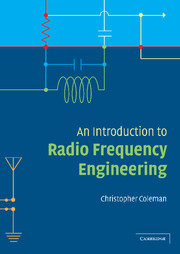Book contents
- Frontmatter
- Contents
- List of figures
- Preface
- Acknowledgements
- 1 Basic concepts
- 2 Frequency selective circuits and matching
- 3 Active devices and amplifiers
- 4 Mixers, modulators and demodulators
- 5 Oscillators and phase locked loops
- 6 Transmission lines and scattering matrices
- 7 Power amplifiers
- 8 Filters
- 9 Electromagnetic waves
- 10 Antennas
- 11 Propagation
- 12 Digital techniques in radio
- Index
5 - Oscillators and phase locked loops
Published online by Cambridge University Press: 05 June 2012
- Frontmatter
- Contents
- List of figures
- Preface
- Acknowledgements
- 1 Basic concepts
- 2 Frequency selective circuits and matching
- 3 Active devices and amplifiers
- 4 Mixers, modulators and demodulators
- 5 Oscillators and phase locked loops
- 6 Transmission lines and scattering matrices
- 7 Power amplifiers
- 8 Filters
- 9 Electromagnetic waves
- 10 Antennas
- 11 Propagation
- 12 Digital techniques in radio
- Index
Summary
The generation of a stable sinusoidal signal is a crucial function in most RF systems. A transmitter will amplify and suitably modulate such a signal in order to produce its required output. In the case of a receiver system, such a signal is fed into the mixer circuits for the purposes of frequency conversion and demodulation. A circuit that generates a repetitive waveform is known as an oscillator. Such circuits usually consist of an amplifier with positive feedback that causes any input, however small, to grow until limited by the non-linearities of the circuit. The feedback will need to be frequency selective in order to control the rate of waveform repetition. This frequency selection is often achieved using combinations of capacitors and inductors, but can also be achieved with resistor and capacitor combinations. In the present chapter, however, we will concentrate on feedback circuits based on capacitor/inductor combinations. We consider a variety of oscillator circuits that are suitable for RF purposes and investigate the conditions under which oscillation occurs. In addition, we consider the issue of oscillator noise since this can often pose a severe limitation upon system performance.
A particularly important class of oscillator is that for which the frequency can be controlled by a d.c. voltage. Such an oscillator is an important element in what is known as a phase locked loop. In such a system, there is a feedback loop that compares the oscillator output with a reference signal and generates a control voltage based upon their phase difference.
Information
- Type
- Chapter
- Information
- An Introduction to Radio Frequency Engineering , pp. 108 - 131Publisher: Cambridge University PressPrint publication year: 2004
